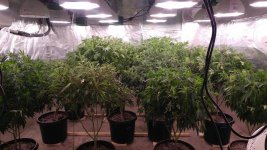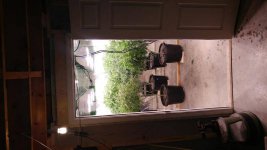Hi, I've been lurking and reading for months doing research across the web and among friends. I'm small partner in a commercial grow operation, and I'm branching out on my own.
Our commercial warehouse operation is all Gavita 1000w HPS, other than a handful of T5s in the vegging rooms. I started down that road, believing I'd keep those same lights (because that's what all the established growers are saying) but my initial budget is small ($12,000 US) and I only have 8' ceilings.... so I began looking for alternative lighting that didn't involve as much heat. That's when I took the path to believing in CMH.
All of my grow area for initial operations will be just under 8' ceiling. It's my unfinished basement. My initial space, Phase 1, is a 13x13 flower-only room - I'll be vegging at our commercial facility to begin with. After that, I'll be able to build 2 additional 13x13 rooms, with a 26' long, 5'wide "hall" between the rooms (the Phase 1 first room is 5' from the stairs, the Phase 2 room and Phase 3 room will be 13x13 rooms flanking the hallway which runs alongside the stairs through the back of the basement).
Soo... at the point where I've come up with a decent beginning plan, I figure I'll throw out what I have and see just how far off-base I am, and what I should adjust...
Room Build:
Wall studs for the interior walls, sheetrock over them. Foamboard insulation glued on the outside (concrete) walls, framed with some studs, and sheetrocked as well. Sheetrock on ceiling. Am mudding and taping seams. Plan to use silicone and/or hvac foil tape on air leak problem spots. Was considering painting and using poly as a vapor barrier. Then read about elastomeric paint to seal the sheetrock. All of that lead to research on 11 mil Orca film (not 6 mil Panda) which would provide 1) a good seal as well as 2) a 94% diffuse reflective surface and 3) could easily be stretched and clamped in place using a technique I know from stretching poly on greenhouses, while 4) being relatively easy to clean up. White concrete epoxy on the floor. Possibly covered with Orca poly. Not sure about that last part.
Lights:
12 CMH fixtures. Leaning toward Cycloptics Greenbeams complete fixture. Though the price is about $125 steeper per fixture than the cost of a comparable Phantom Reflector/Ballast fixture. Bulbs will be Philips Agro 3100.
Controller/Other
Link4 624 controller. Titan Controls Helios light controller, TC CO2 regulator. CO2 tank, no burner for now. 25' of TC CO2 rain tube. 9K head of a 24K BTU mini-split. 4 16" wall-mount fans. 1 Floorstanding 16" fan, 1 16" floor-height pivot fan. 8" Active Air fan, Phresh Filter, Phat Muffler for air scrubbing.
Water/Medium/Nutes:
Ideal 1400 GPD chlorine filter. 40 gallon holding tank, aerator, heater, 1/4 HP utility pump and hose. 30 gallon mix tub for nutes. 1/4 HP utility pump and hose. Plants will have vegged for 8-9 weeks, and super-topped to be 2-2.5' wide and about 2.5' tall, and will be in 15 gallon pots of Advanced Nutrients coco/soil blend. Using the Sensi Bloom A+B, Bud Ignitor, and Big Bud from AN. DynaGrow Pro-Tekt, Earth Juice Hi-Brix Molasses. Have thought about an RO unit, but am on the bubble about it beyond the chlorine/choramine issue - am on "town water."
I'm sure I've left out more than a little. Any thoughts on the choices and possible ways to improve on them? I've been reading about UV B and the Far Red/Deep Red benefits, so I'm considering those things at least before going into the second harvest.
Riever
Our commercial warehouse operation is all Gavita 1000w HPS, other than a handful of T5s in the vegging rooms. I started down that road, believing I'd keep those same lights (because that's what all the established growers are saying) but my initial budget is small ($12,000 US) and I only have 8' ceilings.... so I began looking for alternative lighting that didn't involve as much heat. That's when I took the path to believing in CMH.
All of my grow area for initial operations will be just under 8' ceiling. It's my unfinished basement. My initial space, Phase 1, is a 13x13 flower-only room - I'll be vegging at our commercial facility to begin with. After that, I'll be able to build 2 additional 13x13 rooms, with a 26' long, 5'wide "hall" between the rooms (the Phase 1 first room is 5' from the stairs, the Phase 2 room and Phase 3 room will be 13x13 rooms flanking the hallway which runs alongside the stairs through the back of the basement).
Soo... at the point where I've come up with a decent beginning plan, I figure I'll throw out what I have and see just how far off-base I am, and what I should adjust...
Room Build:
Wall studs for the interior walls, sheetrock over them. Foamboard insulation glued on the outside (concrete) walls, framed with some studs, and sheetrocked as well. Sheetrock on ceiling. Am mudding and taping seams. Plan to use silicone and/or hvac foil tape on air leak problem spots. Was considering painting and using poly as a vapor barrier. Then read about elastomeric paint to seal the sheetrock. All of that lead to research on 11 mil Orca film (not 6 mil Panda) which would provide 1) a good seal as well as 2) a 94% diffuse reflective surface and 3) could easily be stretched and clamped in place using a technique I know from stretching poly on greenhouses, while 4) being relatively easy to clean up. White concrete epoxy on the floor. Possibly covered with Orca poly. Not sure about that last part.
Lights:
12 CMH fixtures. Leaning toward Cycloptics Greenbeams complete fixture. Though the price is about $125 steeper per fixture than the cost of a comparable Phantom Reflector/Ballast fixture. Bulbs will be Philips Agro 3100.
Controller/Other
Link4 624 controller. Titan Controls Helios light controller, TC CO2 regulator. CO2 tank, no burner for now. 25' of TC CO2 rain tube. 9K head of a 24K BTU mini-split. 4 16" wall-mount fans. 1 Floorstanding 16" fan, 1 16" floor-height pivot fan. 8" Active Air fan, Phresh Filter, Phat Muffler for air scrubbing.
Water/Medium/Nutes:
Ideal 1400 GPD chlorine filter. 40 gallon holding tank, aerator, heater, 1/4 HP utility pump and hose. 30 gallon mix tub for nutes. 1/4 HP utility pump and hose. Plants will have vegged for 8-9 weeks, and super-topped to be 2-2.5' wide and about 2.5' tall, and will be in 15 gallon pots of Advanced Nutrients coco/soil blend. Using the Sensi Bloom A+B, Bud Ignitor, and Big Bud from AN. DynaGrow Pro-Tekt, Earth Juice Hi-Brix Molasses. Have thought about an RO unit, but am on the bubble about it beyond the chlorine/choramine issue - am on "town water."
I'm sure I've left out more than a little. Any thoughts on the choices and possible ways to improve on them? I've been reading about UV B and the Far Red/Deep Red benefits, so I'm considering those things at least before going into the second harvest.
Riever






